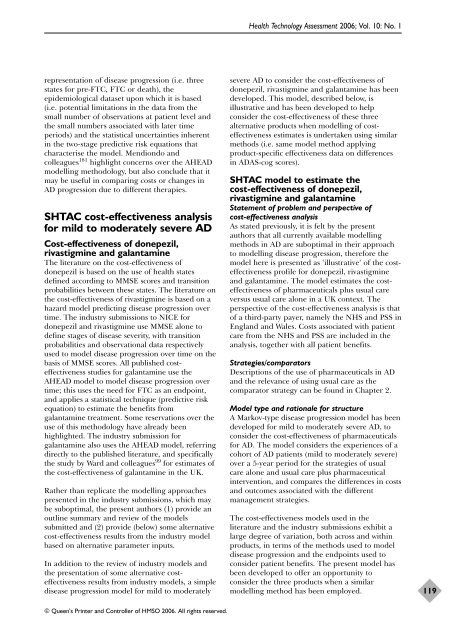Donepezil, rivastigmine, galantamine and memantine for ...
Donepezil, rivastigmine, galantamine and memantine for ...
Donepezil, rivastigmine, galantamine and memantine for ...
You also want an ePaper? Increase the reach of your titles
YUMPU automatically turns print PDFs into web optimized ePapers that Google loves.
epresentation of disease progression (i.e. three<br />
states <strong>for</strong> pre-FTC, FTC or death), the<br />
epidemiological dataset upon which it is based<br />
(i.e. potential limitations in the data from the<br />
small number of observations at patient level <strong>and</strong><br />
the small numbers associated with later time<br />
periods) <strong>and</strong> the statistical uncertainties inherent<br />
in the two-stage predictive risk equations that<br />
characterise the model. Mendiondo <strong>and</strong><br />
colleagues 181 highlight concerns over the AHEAD<br />
modelling methodology, but also conclude that it<br />
may be useful in comparing costs or changes in<br />
AD progression due to different therapies.<br />
SHTAC cost-effectiveness analysis<br />
<strong>for</strong> mild to moderately severe AD<br />
Cost-effectiveness of donepezil,<br />
<strong>rivastigmine</strong> <strong>and</strong> <strong>galantamine</strong><br />
The literature on the cost-effectiveness of<br />
donepezil is based on the use of health states<br />
defined according to MMSE scores <strong>and</strong> transition<br />
probabilities between these states. The literature on<br />
the cost-effectiveness of <strong>rivastigmine</strong> is based on a<br />
hazard model predicting disease progression over<br />
time. The industry submissions to NICE <strong>for</strong><br />
donepezil <strong>and</strong> <strong>rivastigmine</strong> use MMSE alone to<br />
define stages of disease severity, with transition<br />
probabilities <strong>and</strong> observational data respectively<br />
used to model disease progression over time on the<br />
basis of MMSE scores. All published costeffectiveness<br />
studies <strong>for</strong> <strong>galantamine</strong> use the<br />
AHEAD model to model disease progression over<br />
time; this uses the need <strong>for</strong> FTC as an endpoint,<br />
<strong>and</strong> applies a statistical technique (predictive risk<br />
equation) to estimate the benefits from<br />
<strong>galantamine</strong> treatment. Some reservations over the<br />
use of this methodology have already been<br />
highlighted. The industry submission <strong>for</strong><br />
<strong>galantamine</strong> also uses the AHEAD model, referring<br />
directly to the published literature, <strong>and</strong> specifically<br />
the study by Ward <strong>and</strong> colleagues99 <strong>for</strong> estimates of<br />
the cost-effectiveness of <strong>galantamine</strong> in the UK.<br />
Rather than replicate the modelling approaches<br />
presented in the industry submissions, which may<br />
be suboptimal, the present authors (1) provide an<br />
outline summary <strong>and</strong> review of the models<br />
submitted <strong>and</strong> (2) provide (below) some alternative<br />
cost-effectiveness results from the industry model<br />
based on alternative parameter inputs.<br />
In addition to the review of industry models <strong>and</strong><br />
the presentation of some alternative costeffectiveness<br />
results from industry models, a simple<br />
disease progression model <strong>for</strong> mild to moderately<br />
© Queen’s Printer <strong>and</strong> Controller of HMSO 2006. All rights reserved.<br />
Health Technology Assessment 2006; Vol. 10: No. 1<br />
severe AD to consider the cost-effectiveness of<br />
donepezil, <strong>rivastigmine</strong> <strong>and</strong> <strong>galantamine</strong> has been<br />
developed. This model, described below, is<br />
illustrative <strong>and</strong> has been developed to help<br />
consider the cost-effectiveness of these three<br />
alternative products when modelling of costeffectiveness<br />
estimates is undertaken using similar<br />
methods (i.e. same model method applying<br />
product-specific effectiveness data on differences<br />
in ADAS-cog scores).<br />
SHTAC model to estimate the<br />
cost-effectiveness of donepezil,<br />
<strong>rivastigmine</strong> <strong>and</strong> <strong>galantamine</strong><br />
Statement of problem <strong>and</strong> perspective of<br />
cost-effectiveness analysis<br />
As stated previously, it is felt by the present<br />
authors that all currently available modelling<br />
methods in AD are suboptimal in their approach<br />
to modelling disease progression, there<strong>for</strong>e the<br />
model here is presented as ‘illustrative’ of the costeffectiveness<br />
profile <strong>for</strong> donepezil, <strong>rivastigmine</strong><br />
<strong>and</strong> <strong>galantamine</strong>. The model estimates the costeffectiveness<br />
of pharmaceuticals plus usual care<br />
versus usual care alone in a UK context. The<br />
perspective of the cost-effectiveness analysis is that<br />
of a third-party payer, namely the NHS <strong>and</strong> PSS in<br />
Engl<strong>and</strong> <strong>and</strong> Wales. Costs associated with patient<br />
care from the NHS <strong>and</strong> PSS are included in the<br />
analysis, together with all patient benefits.<br />
Strategies/comparators<br />
Descriptions of the use of pharmaceuticals in AD<br />
<strong>and</strong> the relevance of using usual care as the<br />
comparator strategy can be found in Chapter 2.<br />
Model type <strong>and</strong> rationale <strong>for</strong> structure<br />
A Markov-type disease progression model has been<br />
developed <strong>for</strong> mild to moderately severe AD, to<br />
consider the cost-effectiveness of pharmaceuticals<br />
<strong>for</strong> AD. The model considers the experiences of a<br />
cohort of AD patients (mild to moderately severe)<br />
over a 5-year period <strong>for</strong> the strategies of usual<br />
care alone <strong>and</strong> usual care plus pharmaceutical<br />
intervention, <strong>and</strong> compares the differences in costs<br />
<strong>and</strong> outcomes associated with the different<br />
management strategies.<br />
The cost-effectiveness models used in the<br />
literature <strong>and</strong> the industry submissions exhibit a<br />
large degree of variation, both across <strong>and</strong> within<br />
products, in terms of the methods used to model<br />
disease progression <strong>and</strong> the endpoints used to<br />
consider patient benefits. The present model has<br />
been developed to offer an opportunity to<br />
consider the three products when a similar<br />
modelling method has been employed.<br />
119
















